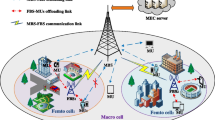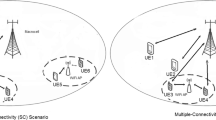Abstract
Mobile data offloading is a current-day networking paradigm to channelize certain fraction of the cellular data traffic over unlicensed spectrum of WiFi. In this paper, we present a novel data offloading scheme built upon the exponential learning-based minority game (MG) theory. Performance comparison between cellular and WiFi services with respect to the offered load, has been used to derive an appropriate offloading condition for our proposed MG-based distributed data offloading algorithm. Effectiveness of the MG algorithm is tested by studying its performance through extensive simulation by varying several important parameters, like, pricing parameter \(\beta\), cellular offered throughput (\(S_{{c}}\)), and temperature coefficient of the algorithm (\(\gamma\)). An effective model for tuning pricing parameter \(\beta\) with respect to the offered load (named as, Target Pricing scheme) is also presented using reverse engineering approach by considering the dynamic traffic condition. We have provisioned the application of our algorithm in multi-access point environment. We have studied the behaviour of different classes of nodes in heterogeneous population, while applying a MG-based networking algorithm. Through extensive NS3 based simulation we have evaluated the performance of our proposed algorithm in an IEEE 802.11ax environment and studied the effect of MIMO, QoS, transport layer and unsaturated traffic condition.
















Similar content being viewed by others
Data availability statement
All data generated or analysed during this study are included in this published article.
References
Cisco annual internet report (2018–2023) white paper (2020). https://www.cisco.com/c/en/us/solutions/collateral/executive-perspectives/annual-internet-report/white-paper-c11-741490.html. Accessed 20 September, 2020
Unlicensed spectrum may be critical to 5g. IEEE Spectrum. https://spectrum.ieee.org/computing/it/unlicensed-spectrum-may-be-critical-to-5g. Accessed 20 September, 2020
Charilas, D. E., & Panagopoulos, A. D. (2010). A survey on game theory applications in wireless networks. Computer Networks, 54(18), 3421–3430.
Lasaulce, S., & Tembine, H. (2011). Game theory and learning for wireless networks: Fundamentals and applications (1st ed.). Academic Press Inc.
Semasinghe, P., Maghsudi, S., & Hossain, E. (2017). Game theoretic mechanisms for resource management in massive wireless iot systems. IEEE Communications Magazine, 55(2), 121–127. https://doi.org/10.1109/MCOM.2017.1600568CM.
Challet, D., & Zhang, Y. C. (1997). Emergence of cooperation and organization in an evolutionary game. Physica A: Statistical Mechanics and its Applications, 246(3), 407–418.
Arthur, W. B. (1994). Inductive reasoning and bounded rationality. The American Economic Review, 84(2), 406–411.
Challet, D., Marsili, M., & Zhang, Y. C. (2004). Minority games: Interacting agents in financial markets. Oxford University Press.
Zhou, H., Wang, H., Li, X., & Leung, V. C. M. (2018). A survey on mobile data offloading technologies. IEEE Access, 6, 5101–5111.
Rimal, B. P., & Maier, M. (2017). Mobile data offloading in fiwi enhanced lte-a heterogeneous networks. IEEE/OSA Journal of Optical Communications and Networking, 9(7), 601–615.
Saha, N., & Vesilo, R. (2018). An evolutionary game theory approach for joint offloading and interference management in a two-tier hetnet. IEEE Access, 6, 1807–1821.
Apostolaras, A., Iosifidis, G., Chounos, K., Korakis, T., & Tassiulas, L. (2016). A mechanism for mobile data offloading to wireless mesh networks. IEEE Transactions on Wireless Communications, 15(9), 5984–5997.
Kouyoumdjieva, S. T., & Karlsson, G. (2016). Energy-aware opportunistic mobile data offloading under full and limited cooperation. Computer Communications, 84, 84–95.
Ajith, A., & Venkatesh, T. G. (2017). Qoe enhanced mobile data offloading with balking. IEEE Communications Letters, 21(5), 1143–1146.
Rohoden, K., Estrada, R., Otrok, H., & Dziong, Z. (2020). Evolutionary game theoretical model for stable femtocells’ clusters formation in hetnets. Computer Communications, 161, 266–278.
Saito, Y., Yamamoto, K., Murata, H., & Yoshida, S. (2010). Robust interference management to satisfy allowable outage probability using minority game. In IEEE PMIRC (pp. 2314–2319). https://doi.org/10.1109/PIMRC.2010.5671703
Mähönen, P., & Petrova, M. (2008). Minority game for cognitive radios: Cooperating without cooperation. Physical Communication, 1(2), 94–102.
Majumder, B., Venkatesh, T. G., & Vuppalapati, N. (2020). Wireless mac protocol based on crowd-anticrowd theory. In 2020 International conference on advances in computing and communication engineering (ICACCE) (pp. 1–6).
Wang, Y., Yuan, J., Yu, G., Chen, Q., & Yin, R. (2020). Minority game for distributed user association in unlicensed heterogenous networks. IEEE Transactions on Wireless Communications, 19(6), 4220–4233.
Sikeridis, D., Tsiropoulou, E. E., Devetsikiotis, M., & Papavassiliou, S. (2018). Wireless powered public safety iot: A uav-assisted adaptive-learning approach towards energy efficiency. Journal of Network and Computer Applications, 123, 69–79.
Bianchi, G. (2000). Performance analysis of the ieee 802.11 distributed coordination function. IEEE Journal on Selected Areas in Communications, 18(3), 535–547.
Błaszczyszyn, B., Jovanovicy, M., & Karray, M. K. (2014). How user throughput depends on the traffic demand in large cellular networks. In 2014 12th international symposium on modeling and optimization in mobile, ad hoc, and wireless networks (WiOpt) (pp. 611–619). https://doi.org/10.1109/WIOPT.2014.6850355
Riley, G. F., & Henderson, T. R. (2010). The ns-3 network simulator. In Modeling and tools for network simulation (pp. 15–34). Springer.
Acknowledgements
Authors wish to acknowledge Mrs.Aparna Behara, Electrical Engineering, Indian Institute of Technology, Madras, for helping in NS3-simulation setup.
Author information
Authors and Affiliations
Corresponding author
Ethics declarations
Conflict of interest
On behalf of all authors, the corresponding author states that there is no conflict of interest.
Additional information
Publisher's Note
Springer Nature remains neutral with regard to jurisdictional claims in published maps and institutional affiliations.
Appendix
Appendix
This appendix explains the various parameters used in Eq. 4. E[P] refers to the average payload size, and \(T_{\sigma }\) denotes the duration of an empty slot time. Additionally, \(T_s\) refers to the average time the channel is sensed busy because of a successful transmission, and \(T_c\) is the average time the channel is sensed busy by each node during a collision. Next, considering IEEE 802.11 basic access mechanism, \(T_s\) and \(T_c\) are given by:
C, SIFS, DIFS, ACK, \(\delta\), H denote the WiFi channel bit rate, short inter-frame spacing, distributed inter-frame spacing, duration of the acknowledgement, the propagation delay and header length in bits respectively, whose default values are given in Table 2. Again, H is given by:
However, if the WLAN is operated in RTS-CTS mode, \(T_s\) and \(T_c\) are defined as follows:
Rights and permissions
About this article
Cite this article
Majumder, B., Venkatesh, T.G. Mobile data offloading based on minority game theoretic framework. Wireless Netw 28, 2967–2982 (2022). https://doi.org/10.1007/s11276-022-02993-z
Accepted:
Published:
Issue Date:
DOI: https://doi.org/10.1007/s11276-022-02993-z




